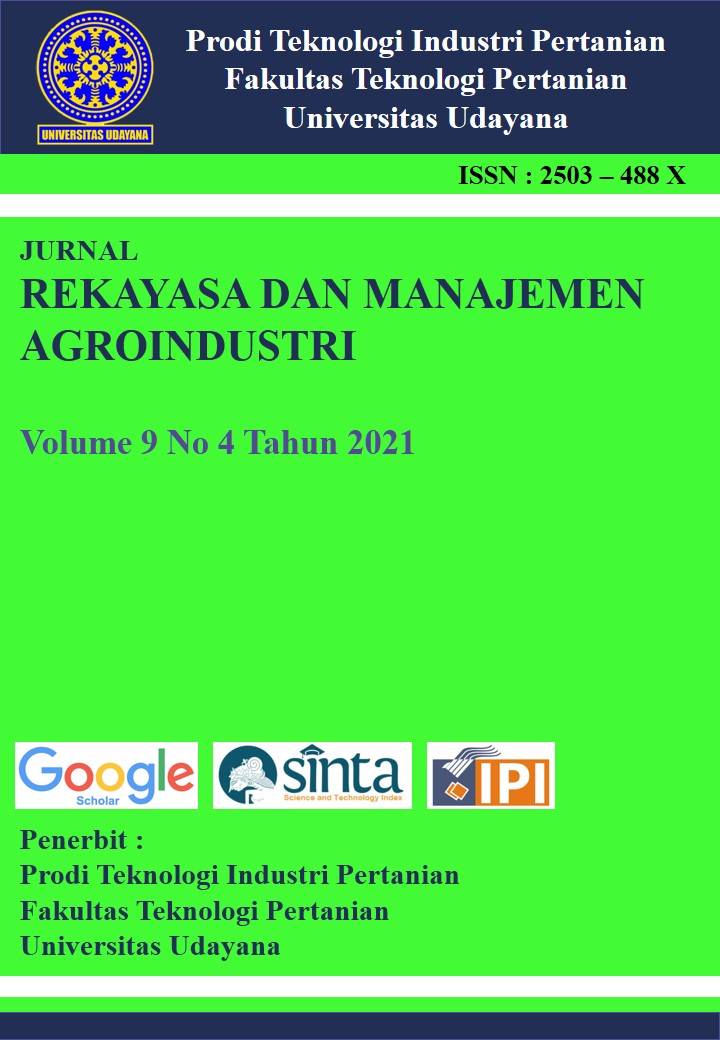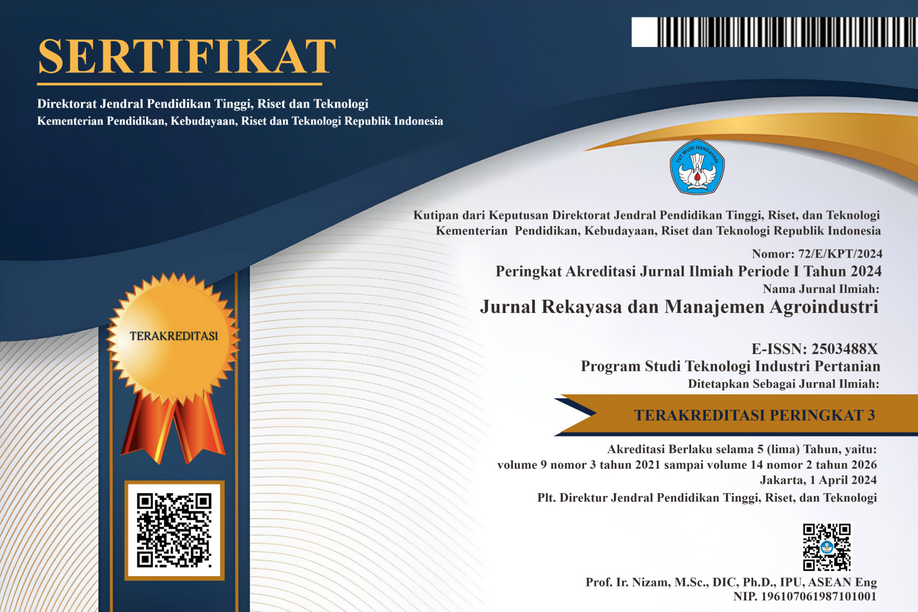Pengaruh Persentase Ampas Kopi Robusta (Coffea canephora) dan Suhu Pemanasan terhadap Karakteristik Body Scrub
Abstract
Body scrub is one of the cosmetic products used for skin care. Body scrubs have coarse granules that function to remove dead skin cells and clean the skin optimally, which is called abrasive or sanding. This study aims to determine the effect of the percentage og coffee grounds and heating temperature and their interaction on the characteristics of the body scrub and to determine the percentage of coffee grounds and the right heating temperature so as to produce a body scrub with the best characteristics. This study used a factorial randomized block design with two factors. The first factor is the percentage of coffee grounds with 3 levels, namely 4, 6 and 8%, while the second factor is the heating temperature with 3 levels, namely 65, 70 and 75?C. The results showed that the percentage of coffee grounds had an effect on ph, viscosity, spreadability, adhesion, total phenolic compounds and overall body scrub acceptance. The heating temperature affects the viscosity, spreadability, adhesion, total phenolic compounds and overall acceptance of the body scrub but the heating temperature has no effect on the ph of the body scrub. The interaction between the percentage of coffee grounds and the heating temperature had no effect on ph, viscosity, spreadability, adhesion, total phenolic compounds and overall acceptance of the body scrub. The percentage of 4% coffee grounds and a heating temperature of 65?C is the best treatment of body scrub with characteristics of ph 5.93, viscosity of 7600 cp, dispersion of 5.6 cm, adhesion of 5.78 seconds, separation ratio = 1, total phenolic compounds 1.52 mg GAE/g and overall acceptance was 4.95 (regular to moderate).
Keywords : body scrub, coffee ground, heating temperature
Downloads
References
Adline, A. A. 2013. Antimicrobial and antioxidant activities of microwave-assited extracts from coffee ground residue in chiang rai province, Thailand.
Amallyah, B. 2013. Stabilitas fisika sediaan body scrub mengandung bekatul, rice bran oil, virgin coconut oil (VCO) kopi ekstrak aloe vera. Jurnal Ilmiah Mahasiswa Universitas Negeri Surabaya. 3(1): 1-1.
Badan Standarisai Nasional. 1996. Sediaan Tabir Surya. Standar Nasional Indonesia. Jakarta
Depkes RI. 2010. Formularium Kosmetika Indonesia. Departemen Kesehatan Republik Indonesia, Jakarta.
Dwiastuti, R. 2009. Optimasi proses pembuatan krim sunscreen ekstrak kering polifenol teh hijau (Camelia sinensis L) dengan metode desai faktorial. Universitas Gadjah Mada, Yogyakarta.
Erwiyani, A.S., D. Destiani dan S. A. Kabelen. 2018. Pengaruh lama penyimpanan sediaan fisik krim daun alpukat (Persea americana Mill) dan daun sirih hijau (Piper betle Linn). Jurnal Farmasi dan Produk. 01 (01): 23-29.
Garg, A., D. Aggarwal., S Garg. and A.K Singla.2002. Spreading of semisolid formulation. Journal Pharmaceutical Technology. 26 (9): 84-105.
Gitariastuti, N.K., S. Mulyani, dan L.P. Wrasiati. 2019. Pengaruh penambahan bubuk daun kelor (Moringa oleifera L.) dan suhu proses pemanasan terhadap karakteristik body scrub. Jurnal Rekayasa dan Manajemen Agroindustri. 8(1) : 18-21.
Hardiyanthi, F. 2015. Pemanfaatan Aktivitas Antioksidan Ekstrak Daun Kelor (Moringa oilefera) dalam Sediaan Hand and Body Cream. Skripsi S1. Tidak dipublikasikan. Fakultas Sains dan Teknologi UIN, Jakarta.
Isfianti, D.E., dan O.K. Pritasari. 2018. Pemanfaatan limbah kulit buah jeruk nipis (Citrus aurantifolia) dan daun kelor (Moringa Oleifera L.) untuk pembuatan lulur tradisional sebagai alternatif green cosmetic. E-Journal, Universitas Negeri Surabaya. 7(2): 74-84.
Juliantari, N.P.D., L.P. Wrasiati dan N.M. Wartini. 2018. Karakteristik ekstrak ampas kopi bubuk robusta (Coffea canephora) pada perlakuan konsentrasi pelarut etanol dan suhu maserasi. Jurnal Rekayasa Manajemen Agroindustri. 6(3) : 243-249
Kanza, A.M. 2016. Formulasi Body Scrub Dari Ampas Kopi. Skripsi S1. Tidak Dipublikasikan. Fakultas Teknologi Pertanian, Institut Pertanian Bogor, Bogor.
Kurniasih, N. 2016 Formulasi Sediaan Krim Tipe M/A Ekstrak Biji Kedelai (Glycnine max L) : Uji Stabilitas Fisik dan Efek pada Kulit. Skripsi S1. Tidak dipublikasikan. Universitas Muhammadiyah Surakarta, Surakarta.
Natha, R, G., A.A.P.A.S. Wiranatha, A. dan S. Mulyani, 2019. Pengaruh suhu dan penambahan bahan abrasive kulit ari biji kakao terhadap karakteristik krim body scrub. Jurnal Rekayasa dan Manajemen Agroindustri. 7(3) : 417-428.
Niellound, F. and G.M. Mesters. 2000. Pharmaceuticals Emulsions and Suspensions.Marcell. Dekker Inc. 2(11): 561 – 590.
Nurlatifah E. 2014. Analisis Kapasitas Antioksidan dan Kandungan Total Fenol pada Rempah dan Bahan Penyegar. Skripsi S1. Tidak dipublikasikan. Institut Pertanian Bogor, Bogor.
Pamungkas, T, M., Masrukan dan Kuntjahjawati, 2021. Pengaruh suhu dan lama penyangraian (Roasting) terhadap sifat fisik dan kimia pada seduhan kopi arabika dari Kabupaten Gayo, Provinsi Aceh. Jurnal Agrotech. 3(2): 1-10.
Perawati, Hasanudin. dan T. Tutuarima. 2018. Studi pembuatan marmalade jeruk kalamansi (Circus microcarpa) dengan variasi suhu dan lama pemanasan. Jurnal Reka Pangan. 12(1): 41-46
Rieger, M. 2000. Harry’s Cosmeticology, Edisi ke-8. Chemical Publishing Co Inc, New York.
Sakanaka, S., Y. Tachibana and Y. Okada. 2003. Preparation and antioxidant properties of extract of Japanese pearsimo leaf tea (Kakinocha-Cha). Journal Food Chemistry: 89:569-575
Setyaningsih, D., A. Apriyantono., dan M.P. Sari. 2010. Analisis Sensori Untuk Indusri Pangan dan Agro. IPB Press, Bogor.
Tranggono dan Latifah, 2007. Pengantar Kosmetologi. PT. Gramedia Pustaka Utama, Jakarta.
Smaoui, S., H. B. Hilma., R. Jarraya., N. G. Kamoun., R. Ellouze., M. Damak. 2012. Cosmetic emulsion of virgin coconut oil : formulation and biophysical evaluation. African Journal of Biotechnology. 11(40): 9664-9671.
Voight, R. 1994. Buku Pelajaran Teknologi Farmasi. Gadjah Mada University Press, Yogyakarta.
Wirantara, Y. 2011. Optimasi Proses Pencampuran Hand Krim dengan Kajian Kecepatan Putar Mixer, Waktu dan Suhu Pencampuran Menggunakan Metode Desain Faktorial. Skripsi. Tidak Dipublikasikan. Fakultas Farmasi Universitas Sanata Dharma, Yogyakarta.
Zapsalis, 1985, Food Chemistry and Nutrional Biochemistry. Jhon Willey and Sons, New York. 453-454

Ciptaan disebarluaskan di bawah Lisensi Creative Commons Atribusi-BerbagiSerupa 4.0 Internasional.
Seluruh artikel di Jurnal ini dapat disebarluaskan atas tetap mencantumkan sumber yang syah. Identitas judul artikel tidak boleh dihilangkan. Penerbit tidak bertangggung jawab terhadap naskah yang dipublikasikan. Isi artikel menjadi tanggung jawab Penulis.














